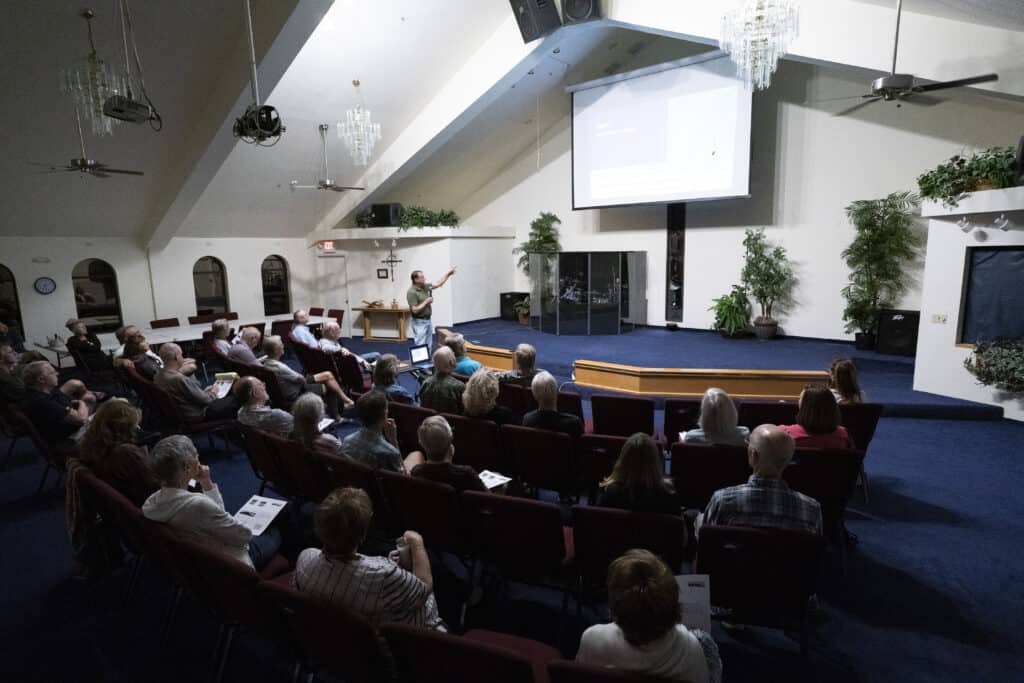The Big Park Regional Coordinating Council nonprofit organization has raised $10,000 to fund legal research by Earthrise, an environmental nonprofit law clinic at Lewis and Clark Law School in Portland, Ore., on its options to possibly prevent Arizona Public Service from constructing a new line near the Village of Oak Creek. The BPRCC recently held a public forum on the proposed project on Wednesday, Sept. 27, at the VOC Church of the Nazarene.

The BPRCC is not a governing body and can only offer recommendations to governing bodies.
“We raised as a maximum, they told us, of $10,000,” BPRCC President John Wichert said. “We’re definitely not at the litigation [stage], but we also want to be prepared in the event that could be necessary. We [are] simply looking at next steps, looking at what’s possible and we’d like to work with the Forest Service.”
No official representatives from APS or the U.S Forest Service were at the meeting.
“The proposed 69kV power line would cross federal lands administered by the [Forest Service] within the [Coconino National Forest], as well as private lands within and between the unincorporated communities of VOC and McGuireville. The project would originate at the existing Oak Creek Substation,” the U.S. Forest Service stated in its draft environmental assessment for the project. “From that point, the power line route would follow an existing 69kV power line to the south, cross [State Route] 179 to a point 1 mile west of [State Route] 179, and then continue in a southerly direction, following parallel to the Kel Fox Trail, south of the VOC. The power line would terminate at the existing McGuireville Substation … The estimated length of the new powerline would be 13.7 miles for either alternative.”
The BPRCC is calling for the line to be buried rather than constructed overland. Based on the figures given in the draft assessment, burying the line would increase the project’s costs from $1.3 million to $7.45 million per mile and from $17.8 million to $96.1 million overall. Modeling by Pacific Gas and Electric showed that undergrounding lines can reduce the risk of igniting a wildfire by approximately 99%. However, the draft assessment also cited existing fires in the area as a justification for the project.
“The project would result in improved region-wide power grid redundancy and reliability,” the assessment stated. “The Oak Creek and McGuireville substations are at the end of long radial segments without a backup source of electricity. Over the past several decades there has been an increase in fire activity in this broader region due in part to the buildout of the wildland urban interface and changing climate conditions. These fires have the potential for impacting critical electrical infrastructure.”
Other concerns expressed by BPRCC members included an overland line’s effect on the viewshed, the wildfire risk from downed lines, the potential decline in property values and what members say is insufficient justification on the part of APS for the need for the line.
“APS is one of the largest electric suppliers in Arizona and the main electric power supplier in the VOC and McGuireville communities,” the draft assessment stated. “APS has determined that additional reliability is needed for these communities.”
APS and the Forest Service have connected the need for improved reliability to the area’s growth.
“To continue to provide reliable service to the Verde Valley, APS has engaged in several years of planning to build a new transmission line from Oak Creek to McGuireville,” APS spokeswoman Yessica Del Rincón said. “This project will help provide more power and redundancy to the residential and business customers moving into the growing area. APS has closely collaborated with the National Forest Service and community members to gather feedback, which was utilized to help shape the project’s location and design in the most affordable, reliable and safest way for customers.”
“The purpose of the proposed project is to improve transmission reliability and operational flexibility, relieve capacity strains on APS power lines in the area and allow for sustained growth for existing and future customers,” was how the assessment described the proposal.
While construction would take place largely within the Coconino National Forest, Yavapai County District 3 Supervisor Donna Michaels [D] has actively campaigned against the above-ground lines.
“I don’t want to see those poles anymore, and added, especially to an iconic view driving down Beaverhead Flat,” Michaels said at a town hall meeting at the Sedona Public Library in the Village on Aug. 24. “It’s unobstructed views, it drives me wild [because] there’s nothing like it, and they’re planning to put poles down there. There’s some spots where they are going to go underground. But … as a social policy person, how much longer are we going to wait and see more people die because poles in severe weather events fall over [and] light fires and kill people? … There’s no place like Arizona and these viewsheds are irreplaceable … I need all of your voices to join with me on it and encourage them to put them underground. They can afford it.”
The Coconino National Forest is in the process of finalizing the environmental assessment, with a draft record of decision anticipated to be released on Friday, Jan. 5, followed by a decision from the regional forester in Albuquerque, N.M., in the spring.